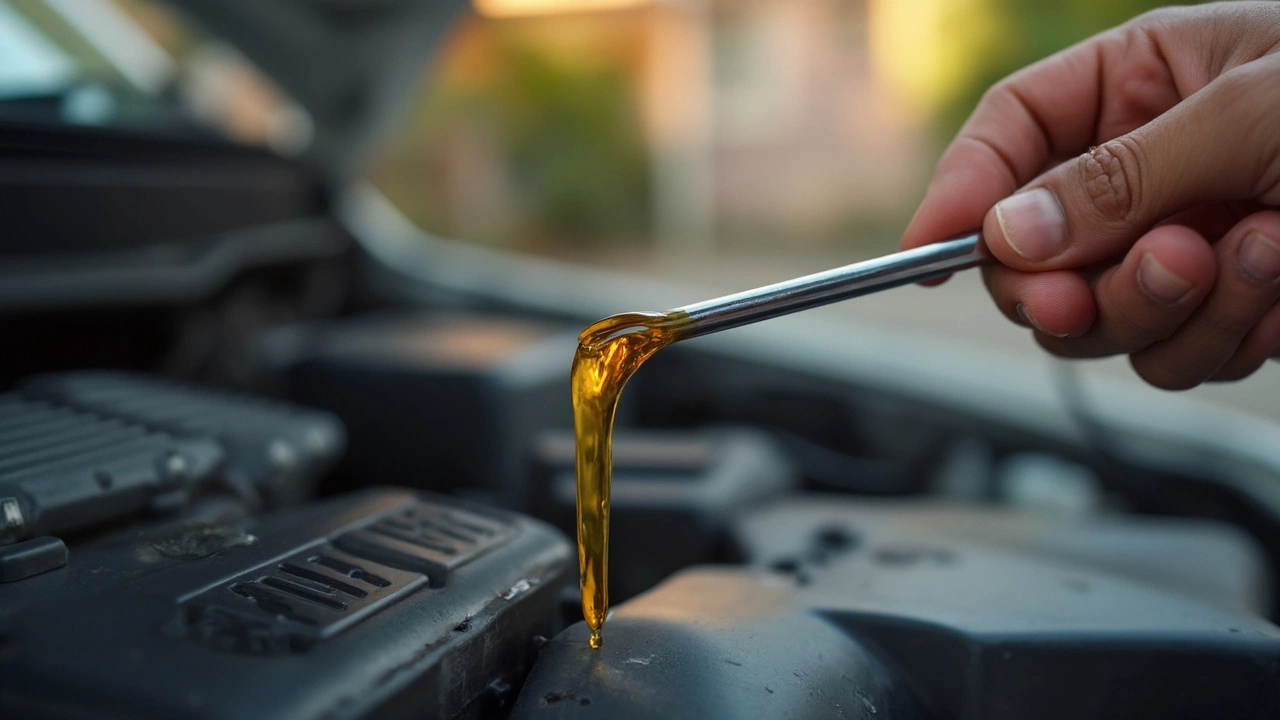 Jun, 10 2025
Jun, 10 2025
Staring at the dipstick and wondering, “Should my oil look like this?” If you’re seeing anything from honey-gold to jet black, you’re not alone. Oil color can freak drivers out, but most of the time, it’s way easier to understand than it first seems.
Fresh oil straight out of the bottle usually has a light amber, almost golden color. The minute it starts running through your engine, it’ll get darker. That’s normal—think of it like a white t-shirt getting a little dingy after a few wears, except it’s picking up tiny bits of carbon and metal as it does its job. New cars may keep the oil clear for longer, but if you’ve got some miles under the hood, oil goes dark faster. So, don’t panic just because yours isn’t as pretty as when you first poured it in.
- Why Oil Color Matters
- What Different Oil Colors Mean
- How to Check Oil on a Dipstick
- Signs to Watch Out For
- When to Change Your Oil
Why Oil Color Matters
Most folks only peek at the dipstick when the oil change sticker starts peeling off the windshield. Here’s the thing: spotting issues early can save your engine and your wallet. Checking your oil color isn’t about keeping things pretty—it’s a quick health check for your car’s lifeline.
If you’ve ever wondered why mechanics stare at oil with such suspicion, it’s because engine oil does way more than just lubricate parts. It moves heat away from critical components, traps dirt, and even helps with fuel efficiency. When oil color changes, it can point to serious trouble, like overheating, coolant leaks, or even metal grinding inside the engine.
Want a few real numbers? According to the American Automobile Association, sludge buildup (which turns oil super dark or milky) is responsible for nearly 5% of all engine failures in cars less than eight years old. That’s more common than most people think.
- If the oil looks gritty or shimmery—think tiny metal flakes—there could be internal engine damage.
- Milky or frothy oil? That sometimes means water or coolant is leaking into the engine, which is a big red flag.
- Extremely dark, thick oil with a burnt smell often shows you’ve waited way too long between oil changes or the engine’s running too hot.
The engine oil color on your dipstick is a cheap, fast signpost. It won’t tell you everything, but ignoring a weird color can mean you miss big problems brewing under the hood.
| Oil Color | Possible Meaning | Action Needed |
|---|---|---|
| Light amber/golden | Fresh oil, engine running well | You're good! |
| Brown/dark brown | Normal use, oil doing its job | Check mileage, change if due |
| Black/sludgy | Very dirty, possible buildup | Change oil soon |
| Milky/foamy | Coolant or water contamination | Get checked by a pro ASAP |
| Shimmery/metallic | Possible internal engine wear | See a mechanic |
What Different Oil Colors Mean
Most people peek at their dipstick and see anything but clear golden oil. So what’s normal and what should worry you? Let’s break it down by color, because oil color is like the engine’s report card.
- Engine oil color: Light amber or golden right after an oil change. This means your oil is still fresh and hasn’t picked up much contamination yet.
- Medium brown: Still okay! This just shows the oil is doing its job, picking up tiny soot and carbon particles. If it’s smooth on your fingers and you can still see through it a bit, no stress.
- Dark brown or black: Super common, especially if you’ve gone a few thousand miles. The important part is not just color, but texture. If it’s not gritty and doesn’t smell burnt, you’re likely fine—but you’re probably getting close to needing a change.
- Milky or frothy: This is a huge red flag. It usually means coolant is leaking into the oil, which can mess up your engine quickly. Don’t drive the car—get a mechanic’s eyes on it right away.
- Thick sludge or visible particles: Not a good sign. This could mean long-overdue oil changes or bigger engine issues.
Here’s a quick table to help you decode what you’re seeing:
| Oil Color | Common Cause | Should You Worry? |
|---|---|---|
| Golden Amber | Fresh oil | Nope, all good |
| Brown | Regular engine use | Not really |
| Black | High mileage since last change | Check if it's gritty. Plan for a change soon |
| Milky/Frothy | Coolant mixing with oil | Yes! Immediate attention needed |
| Shimmery/Sludgy | Old oil, possible engine wear | Get it checked out |
One important tip: the exact color depends a lot on your car’s engine, your driving habits, and even where you live. For instance, short local trips can darken oil faster, especially in cold weather. So, don’t obsess over color alone—mix what you see with how often you drive, the oil’s texture, and your car’s usual schedule.

How to Check Oil on a Dipstick
Checking oil on a dipstick is one of the easiest ways to keep tabs on your engine’s health. Don’t worry—if you can open your hood, you can do this. There’s no need for any special tools, just a clean rag or paper towel. Here’s exactly how you do it right.
- Park your car on a level surface. Let the engine cool for at least five minutes. Hot oil expands and splashes around, which can throw off your reading.
- Pop the hood. On most cars, the dipstick handle is colored (usually yellow or orange), making it easy to spot.
- Pull out the dipstick and wipe it clean with your rag. You want a clear look at the fresh oil reading, not yesterday’s drips.
- Slide the dipstick fully back into its tube, then pull it out again.
- Check the oil level. There are marks or holes at the tip—look for “MIN” and “MAX,” or two dots/lines. The oil should be between these two marks. Too low? Add more. Too high? You’ve probably overfilled, which isn’t great for your engine.
- Now, focus on the color of the oil on the dipstick. Fresh oil is usually amber or golden. As oil ages, it can look dark brown or even black—especially if you drive a lot of city miles. If it’s milky or gritty, that’s bad news and probably means trouble like coolant leaking in or dust getting past your air filter.
If you ever wondered how often people forget this basic check, a 2022 AAA survey found about 35% of drivers skip regular oil checks, leading to more unexpected engine problems down the road. It doesn’t have to be you.
Here’s a quick cheat sheet to what you might see on your dipstick:
| Oil Color | What It Means |
|---|---|
| Amber/Light Brown | Still good, normal for fresh or recently changed oil. |
| Dark Brown/Black | Aged but usually fine unless paired with a gritty feel or burnt smell. |
| Milky | Possible coolant leak. Check with a mechanic ASAP. |
| Foamy/Bubbly | Overfilled or moisture problem. Needs attention. |
| Gritty or Sludgy | Contamination—should change oil and maybe filter. |
If you see anything other than the typical darkening, especially milky or gritty oil, get it checked out. Most engines need an oil change every 5,000 to 7,000 miles, but always check your car’s manual for the exact number.
The oil dipstick is the quickest health check your engine gets. Do it once a month, or before a big road trip. It only takes two minutes but can save you from a blown engine later on.
Signs to Watch Out For
Checking your engine oil color isn’t just about being curious—it’s a quick health check for your car. There are a few warning signs you should never ignore if you spot them on your dipstick.
- Milky or cloudy oil: This usually points to coolant leaking into the oil, probably from a blown head gasket or cracked engine part. If your oil suddenly goes from golden to looking like a coffee milkshake, don’t wait. Get it checked ASAP, because water in the oil can kill your engine fast.
- Gritty texture or visible metal flakes: Run your fingers along the dipstick (after wiping it clean). If you feel any grit or spot metallic specs, your engine’s wearing itself down from the inside. Metal in oil is a major red flag for engine damage.
- Strong burnt smell: Normal oil has a mild, mechanical odor. If it smells burnt, like old toast or charred food, it’s probably been in your engine too long or the engine is running way too hot. Overheated oil can’t protect your engine right.
- Thick, sludgy look: Oil should spread easily and feel slick between your fingers. If it pours like syrup or hangs onto the dipstick in clumps, it’s breaking down. Old sludge can block oil passages and starve your engine for lubrication.
- Strange colors: If the oil looks foamy, dark gray, or unusually greenish, you’ve got something more than simple wear and tear going on. These odd colors can hint at contamination from other engine fluids or even a manufacturing defect.
Want exact data? Here’s a quick look at what typical dipstick oil colors mean and when you should worry:
| Oil Color | Possible Meaning | Action |
|---|---|---|
| Light Amber | Fresh oil, normal | No action needed |
| Medium/Dark Brown | Used oil, still working | Monitor, plan routine oil change |
| Black | Very dirty, old oil | Change soon |
| Milky/Cloudy | Coolant contamination | Seek professional help immediately |
| Metallic or Gritty | Engine wear, metal in oil | Get professional diagnosis |
| Burnt Smell | Overheated, degraded oil | Change oil ASAP, check engine temp |
If your engine oil is any of those problem colors or textures, don’t just wait for the check engine light. Catching these signs early can save you from shelling out for a major repair down the road. Just taking a minute to eyeball that dipstick could keep your ride running longer—and save a lot of money and stress.

When to Change Your Oil
This is the million-dollar question: When should you actually swap out that old oil? It’s not just about the color. Sure, black oil looks old, but color alone doesn’t tell you if it’s time. What matters most is the mileage, time since your last change, and what the manufacturer says for your car.
Most mechanics still use 3,000 miles as a ballpark, but honestly, today’s engines and oils are often good for 5,000–7,500 miles—sometimes even 10,000 miles if you’re using synthetic. Check your owner's manual. It’ll spell out the exact number for your make and model, and trust me, those numbers matter more than oil color alone.
If you’re driving short trips, sitting in a lot of traffic, or dealing with major temperature swings, your engine oil breaks down faster. That means you should stick closer to the lower end of that range. Are you hearing engine ticks, noticing a burnt smell, or seeing that your engine oil color is turning super black and thick? Those are real red flags that you shouldn’t ignore.
- Stick to your car’s recommended interval—it’s usually listed in both months and miles, whichever comes first.
- If your oil feels gritty when you rub it between your fingers, don’t push it any longer. Oil should feel slick, not filled with little bits or sludge.
- If you can’t remember the last time you changed it (or you inherited a used car with mystery oil history), just do it now and reset the clock.
Pro tip: Don’t rely on oil color apps or Internet guesses about what the perfect color should be. Rely on your manufacturer’s advice, keep tabs on how your engine sounds and smells, and get eyeballs on that dipstick at least once a month.